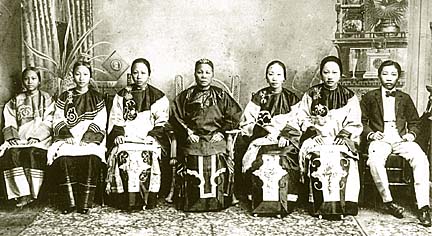


The saga of my ancestors' incredible journey and adventures began 150 years ago in the ancient villages of Nam Long, China. Poverty and fortitude took them to the California Gold Rush before settling on Windward Oahu. Here the family set down roots and produced a lineage of eight generations numbering more than 1,300 descendants today. Ancestors from China
mined rich family sagaREADER REMEMBRANCE
Douglas D.L. Chong / Special to the Star-Bulletin
The tumultuous period of mid-19th-century China found our ancestors ravaged from the Opium War, Taiping Rebellion and famine in southern China. This forced Cantonese into "coolie" labor bound for South America, Central America and Hawaii.
Many like my great-great-grandfather, Lee Dat Boon, ventured off to the Gold Rush only to discover that Chinese were relegated to the dregs of the gold fields. However, after prospecting with meager success, he convinced his son and son-in-law, my great-grandfather, Ching Kan You, to make the sojourn.
While panning in the harsh diggings of the Sacramento Valley, Great-grandfather Ching nearly starved until a fat rabbit tempted him into a rapid chase, only to have the critter pass gas and stun the hunter -- a rude introduction to skunks! He traveled for days to fetch drinking water as the thorny brush ripped his pants to bloody shreds.
Undaunted, great-grandfather patiently gleaned the gold dust and sent it back to China. Eventually, it bought passage for his family and altered the course of our family history.
Meanwhile, Lee Dat Boon had begun to prosper in San Francisco, producing enemies with opposing tongs. After an attempt on his life, great-great-grandfather skipped town one night and sailed away to Hawaii nailed into a salted-salmon barrel. Lee and his son then settled in Kaalaea, operating a rice mill with his son's wife.
Gold soon petered out in Sacramento, so great-grandfather Ching joined the railroad construction laborers, then reclaimed delta land for fruit orchards. Neither venture profited, so he left for the San Francisco laundry houses.
He came to Hawaii and immediately sent for his family. En route, a storm blew great-grandmother's ship off course, and they drifted in the Northwest Pacific for months before landing in San Francisco. The family was finally reunited in Hawaii after sailing the Pacific for six months.
The Chings began their rice plantation in Kaluanui, Punaluu, where food, water and land abounded. Grandmother spoke of her youth when the mountains were lush with fruit and the streams teeming with 'o'opu and 'opae.
They quietly hiked up Sacred Falls and climbed the slopes to pick bags of pepeiao and rose apples.
My great-grandparents bore seven children -- one son, Ching Hung Yau, and six daughters: Mrs. Lum Bung Yun, Mrs. Tom Chung, Mrs. Chun Mun Chu, Mrs. Yuen Sock, Mrs. Luke See Chin and Mrs. Tom You.
Their stories of struggles abound, yet each managed to raise large upstanding families, collectively totaling 47 grandchildren from which we trace our long heritage in Hawaii.